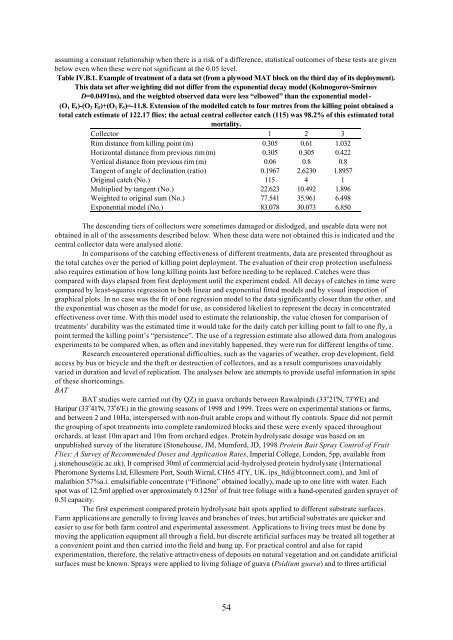“Key Informant Survey” of Production, Value, Losses and ... - DfID
“Key Informant Survey” of Production, Value, Losses and ... - DfID
“Key Informant Survey” of Production, Value, Losses and ... - DfID
Create successful ePaper yourself
Turn your PDF publications into a flip-book with our unique Google optimized e-Paper software.
assuming a constant relationship when there is a risk <strong>of</strong> a difference, statistical outcomes <strong>of</strong> these tests are given<br />
below even when these were not significant at the 0.05 level.<br />
Table IV.B.1. Example <strong>of</strong> treatment <strong>of</strong> a data set (from a plywood MAT block on the third day <strong>of</strong> its deployment).<br />
This data set after we ighting did not differ from the exponential decay model (Kolmogorov-Smirnov<br />
D=0.0491ns), <strong>and</strong> the weighted observed data were less “elbowed” than the exponential model -<br />
(O 1 E 1)-(O 2 E 2)+(O 3 E 3)=-11.8. Extension <strong>of</strong> the modelled catch to four metres from the killing point obtained a<br />
total catch estimate <strong>of</strong> 122.17 flies; the actual central collector catch (115) was 98.2% <strong>of</strong> this estimated total<br />
mortality.<br />
Collector 1 2 3<br />
Rim distance from killing point (m) 0.305 0.61 1.032<br />
Horizontal distance from previous rim (m) 0.305 0.305 0.422<br />
Vertical distance from previous rim (m) 0.06 0.8 0.8<br />
Tangent <strong>of</strong> angle <strong>of</strong> declination (ratio) 0.1967 2.6230 1.8957<br />
Original catch (No.) 115 4 1<br />
Multiplied by tangent (No.) 22.623 10.492 1.896<br />
Weighted to original sum (No.) 77.541 35.961 6.498<br />
Exponential model (No.) 83.078 30.073 6.850<br />
The descending tiers <strong>of</strong> collectors were sometimes damaged or dislodged, <strong>and</strong> useable data were not<br />
obtained in all <strong>of</strong> the assessments described below. When these data were not obtained this is indicated <strong>and</strong> the<br />
central collector data were analysed alone.<br />
In comparisons <strong>of</strong> the catching effectiveness <strong>of</strong> different treatments, data are presented throughout as<br />
the total catches over the period <strong>of</strong> killing point deployment. The evaluation <strong>of</strong> their crop protection usefulness<br />
also requires estimation <strong>of</strong> how long killing points last before needing to be replaced. Catches were thus<br />
compared with days elapsed from first deployment until the experiment ended. All decays <strong>of</strong> catches in time were<br />
compared by least-squares regression to both linear <strong>and</strong> exponential fitted models <strong>and</strong> by visual inspection <strong>of</strong><br />
graphical plots. In no case was the fit <strong>of</strong> one regression model to the data significantly closer than the other, <strong>and</strong><br />
the exponential was chosen as the model for use, as considered likeliest to represent the decay in concentrated<br />
effectiveness over time. With this model used to estimate the relationship, the value chosen for comparison <strong>of</strong><br />
treatments’ durability was the estimated time it would take for the daily catch per killing point to fall to one fly, a<br />
point termed the killing point’s “persistence”. The use <strong>of</strong> a regression estimate also allowed data from analogous<br />
experiments to be compared when, as <strong>of</strong>ten <strong>and</strong> inevitably happened, they were run for different lengths <strong>of</strong> time.<br />
Research encountered operational difficulties, such as the vagaries <strong>of</strong> weather, crop development, field<br />
access by bus or bicycle <strong>and</strong> the theft or destruction <strong>of</strong> collectors, <strong>and</strong> as a result comparisons unavoidably<br />
varied in duration <strong>and</strong> level <strong>of</strong> replication. The analyses below are attempts to provide useful information in spite<br />
<strong>of</strong> these shortcomings.<br />
BAT<br />
BAT studies were carried out (by QZ) in guava orchards between Rawalpindi (33 o 21'N, 73 o 6'E) <strong>and</strong><br />
Haripur (33 o 41'N, 73 o 6'E) in the growing seasons <strong>of</strong> 1998 <strong>and</strong> 1999. Trees were on experimental stations or farms,<br />
<strong>and</strong> between 2 <strong>and</strong> 10Ha, interspersed with non-fruit arable crops <strong>and</strong> without fly controls. Space did not permit<br />
the grouping <strong>of</strong> spot treatments into complete r<strong>and</strong>omized blocks <strong>and</strong> these were evenly spaced throughout<br />
orchards, at least 10m apart <strong>and</strong> 10m from orchard edges. Protein hydrolysate dosage was based on an<br />
unpublished survey <strong>of</strong> the literature (Stonehouse, JM, Mumford, JD, 1998 Protein Bait Spray Control <strong>of</strong> Fruit<br />
Flies: A Survey <strong>of</strong> Recommended Doses <strong>and</strong> Application Rates, Imperial College, London, 5pp, available from<br />
j.stonehouse@ic.ac.uk). It comprised 30ml <strong>of</strong> commercial acid-hydrolysed protein hydrolysate (International<br />
Pheromone Systems Ltd, Ellesmere Port, South Wirral, CH65 4TY, UK. ips_ltd@btconnect.com), <strong>and</strong> 3ml <strong>of</strong><br />
malathion 57%a.i. emulsifiable concentrate (“Fifinone” obtained locally), made up to one litre with water. Each<br />
spot was <strong>of</strong> 12.5ml applied over approximately 0.125m 2 <strong>of</strong> fruit tree foliage with a h<strong>and</strong>-operated garden sprayer <strong>of</strong><br />
0.5l capacity.<br />
The first experiment compared protein hydrolysate bait spots applied to different substrate surfaces.<br />
Farm applications are generally to living leaves <strong>and</strong> branches <strong>of</strong> trees, but artificial substrates are quicker <strong>and</strong><br />
easier to use for both farm control <strong>and</strong> experimental assessment. Applications to living trees must be done by<br />
moving the application equipment all through a field, but discrete artificial surfaces may be treated all together at<br />
a convenient point <strong>and</strong> then carried into the field <strong>and</strong> hung up. For practical control <strong>and</strong> also for rapid<br />
experimentation, therefore, the relative attractiveness <strong>of</strong> deposits on natural vegetation <strong>and</strong> on c<strong>and</strong>idate artificial<br />
surfaces must be known. Sprays were applied to living foliage <strong>of</strong> guava (Psidium guava) <strong>and</strong> to three artificial<br />
54

















